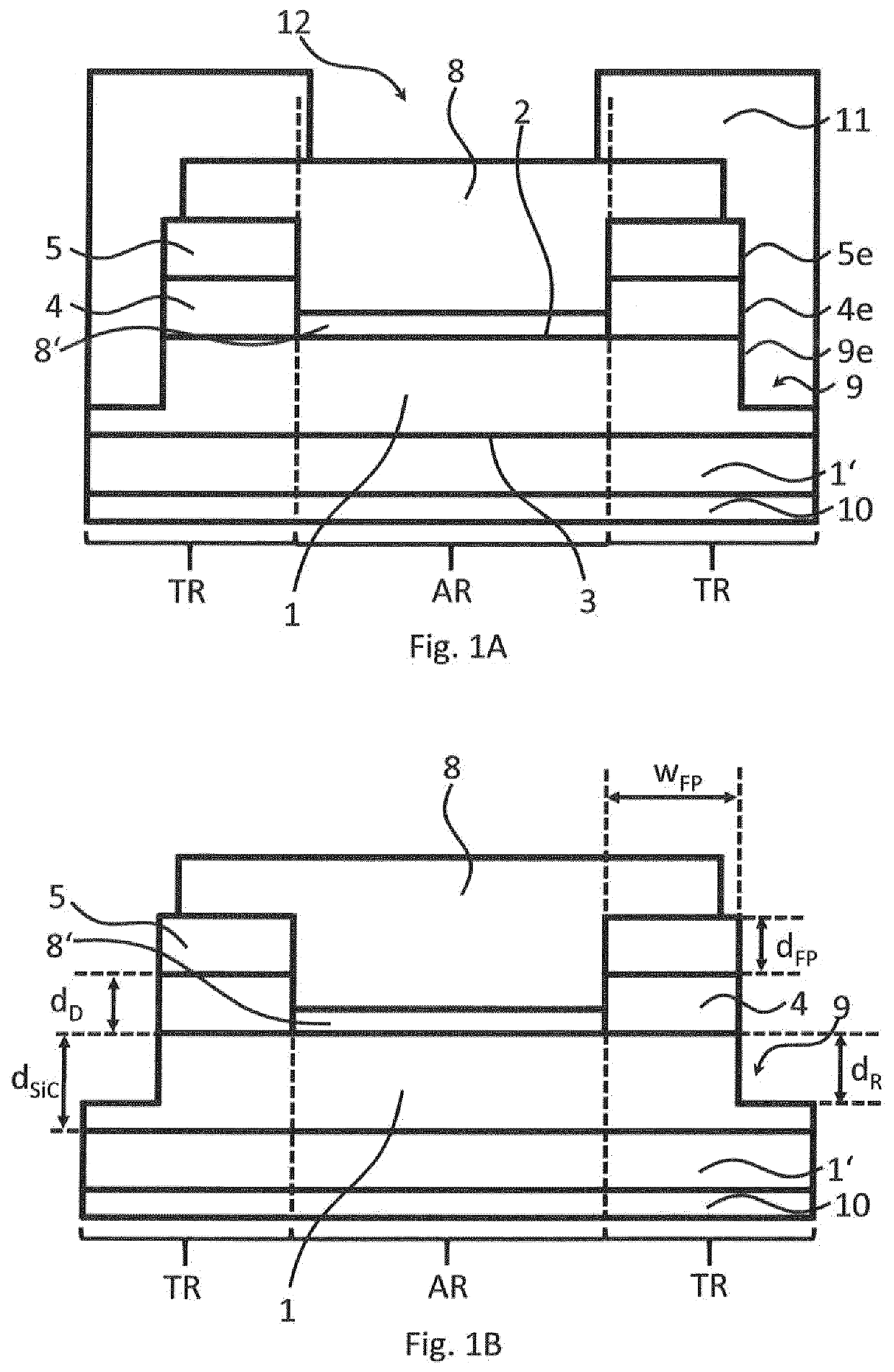Self-Aligned Field Plate Mesa FPM SiC Schottky Barrier Diode
a field plate and barrier diode technology, applied in the direction of diodes, semiconductor devices, electrical equipment, etc., can solve the problems of high difficulty in design of high-performance floating field ring termination, high breakdown voltage vbr, and difficulty in ion implantation in wide-bandgap materials. achieve the effect of high breakdown voltage and high precision
- Summary
- Abstract
- Description
- Claims
- Application Information
AI Technical Summary
Benefits of technology
Problems solved by technology
Method used
Image
Examples
first embodiment
[0050]Referring to FIGS. 1A and 1B, an exemplary embodiment according to the invention comprises an n-type silicon carbide (SiC) layer 1, an n+-type SiC substrate 1′, a dielectric layer 4, a field plate 5, a first recess 9, a backside electrode 10, a frontside electrode (contact electrode 8) and a passivation layer 11.
[0051]The SiC layer 1 (an example of the wide-bandgap semiconductor layer 1 in the claims) is formed on the SiC substrate 1′, has exemplarily a relatively low doping concentration of 1017 cm−3 or less and forms the drift layer in the final power semiconductor device. The SiC substrate 1′ has, for example, a higher doping concentration of 1018 cm−3 or more and is formed on the backside electrode 10. Appropriate doping profiles of the SiC layer 1 and the SiC substrate 1′ for use in a Schottky diode are well known in the prior art. The SiC layer 1 has a first main side 2 and a second main side 3. The first main side 2 and the second main side 3 extend in a lateral directi...
second embodiment
[0059]A second embodiment according to the invention is described with reference to FIG. 1C. Due to the many similarities between the first embodiment and the second embodiment only differences of the first embodiment to the second embodiment are discussed. The remaining features are the same as in the first embodiment and for an explanation thereof it is referred to the first embodiment discussed above with reference to FIGS. 1A to 1B. In contrast to the first embodiment, dielectric layer 4 is formed such that its thickness do increases with increasing lateral distance from the active region AR. The thickness do may increase from a first value to a second value. The thickness may increase continuously from a first value to a second value. The angle between the straight line connecting the first value and the second value and a plane parallel to the first main side may be in the range between 0.1° and 90°, exemplarily between 1° and 10°, more exemplarily between 1° and 5°. The first...
third embodiment
[0060]A third embodiment according to the invention is described with reference to FIG. 1D. Due to the many similarities between the first embodiment and the third embodiment only differences of the first embodiment to the third embodiment are discussed. The remaining features are the same as in the first embodiment and for an explanation thereof it is referred to the first embodiment discussed above with reference to FIGS. 1A and 1B. The third embodiment differs from the first embodiment in that the active region AR of the SiC layer 1 also comprises at least one second recess 14 which has the same depth as the first recess 9 in the termination region TR. The at least one second recess 14 is filled with some filling material, for example insulating material such as a dielectric material or an oxide. This configuration may have a positive effect on leakage currents. The third embodiment may also have the dielectric layer 4 with increasing thickness as shown in the second embodiment.
M...
PUM
| Property | Measurement | Unit |
|---|---|---|
| depth | aaaaa | aaaaa |
| depth | aaaaa | aaaaa |
| thickness | aaaaa | aaaaa |
Abstract
Description
Claims
Application Information
 Login to View More
Login to View More - R&D
- Intellectual Property
- Life Sciences
- Materials
- Tech Scout
- Unparalleled Data Quality
- Higher Quality Content
- 60% Fewer Hallucinations
Browse by: Latest US Patents, China's latest patents, Technical Efficacy Thesaurus, Application Domain, Technology Topic, Popular Technical Reports.
© 2025 PatSnap. All rights reserved.Legal|Privacy policy|Modern Slavery Act Transparency Statement|Sitemap|About US| Contact US: help@patsnap.com



